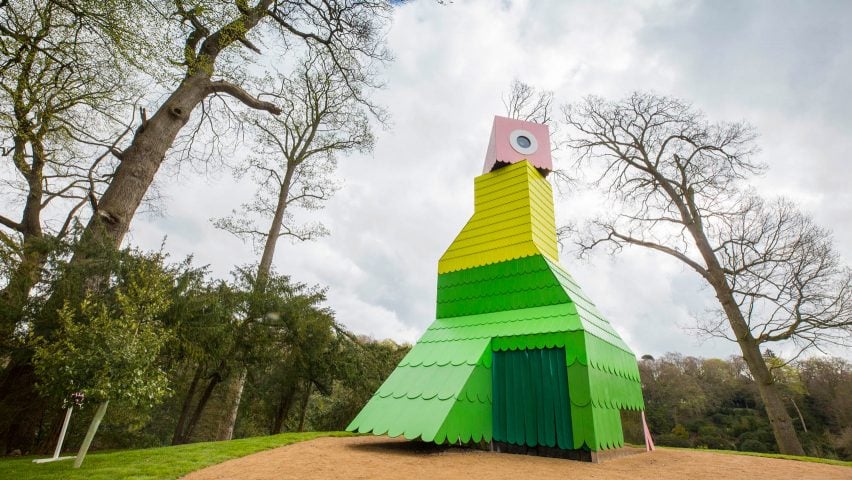Polly is a brightly-coloured pavilion designed by Charles Holland Architects, which has taken up residence in the grounds of Fountains Abbey & Studley Royal in North Yorkshire.
The pavilion is one of four temporary art installations that can be found in the water gardens of the National Trust property, as part of the Folly! 2018 programme of outdoor sculpture.
Charles Holland Architects drew on the history of follies in British architecture and 18th century art to design the nine-metre-high tower in the shape of an angular parrot.
The exotic birds feature in a foliage-filled frieze decorating a church in the Studley Royal grounds, and also Jakab Bogdany's early 1700s painting: Parrots and a Lizard in a Picturesque Garden.
The body of the bird is formed from a steel frame clad in scallop-edged timber shingles in green and yellow to resemble avian plumage. The pavilion is topped with a pink head and tailed by pink feet.
The boxy shape is a reference to the tents and temporary buildings that were once used to host parties on the site.
Mirrored panels around the base make it appear as though the parrot is perched on he top of the hill, it's foundations hovering over the ruins of the temple that can still be found on the spot.
"I have always been fascinated by English landscape gardens and the tradition of folly building," said Charles Holland.
"These landscapes and objects are delightful and fascinating, but underpinning them are powerful themes of wealth and power."
In the 18th century follies were the preserve of the wealthy, who populated their carefully constructed landscaped gardens with menageries stuffed with exotic animals and these expensive ornamental buildings that served no practical purpose.
In another nod to the complicated history of property and power implicit in folly architecture and the history of Studley Royal, Holland installed a lens in Polly's head, which can rotate the full 360 degrees.
Within the pavilion the lens projects a camera obscura image of the surrounding park onto its interior walls.
At this property Holland is engaging with the history of the water gardens.
Disgraced 18th century politician John Aislabie, who was involved in the scandal of the South Sea Bubble, inherited the Studley the estate from his mother's side and set about creating one of England's first landscaped gardens.
Frustrated at being thwarted in his dream of buying the nearby ruins of Fountains Abbey, Aislabie designed a route through the garden that leads to a viewpoint of the abbey so he could at least own the view. Holland's Polly allows visitors to own any view they like of the park, as part of a public art show.
As part of his former practice FAT, Holland was one of the architects behind artist Grayson Perry's A House For Essex, a colourful fairy-tale house on the coast that combined elements of folly, lighthouse and shrine architecture.
Three other designers have also installed their own take on follies in the National Trust grounds. Artist partnership Lucy + Jorge Orta has designed Gazing Ball, a four-metre-high pentagonal steel sculpture crowned by a mirrored sphere that reflects the gardens and ponds.
Flea Folly Architects has made the three-metre-high Bathing House Listening Tower, a white structure containing a copper water collector where dripping sounds are amplified by internal trumpets, meant to echo the bath house folly that once stood in the gardens.
The fourth folly is the creation of 11-year-old Foster Carter, who won a competitions held by the North Yorkshire Society of Architects with his plans for a cloud that sits on a wooden frame in a nod to the inclement weather of North Yorkshire.
Folly! runs from April 28 to November 4 2018.
Photography is by Chris Lacey.

